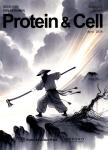Crystal structure of the ubiquitin-like domain of human TBK1
人的 TBK1 的象 ubiquitin 一样领域的水晶结构作者机构:State Key Laboratory of BiomacromoleculesInstitute of BiophysicsChinese Academy of SciencesBeijing 100101China Department of MicrobiologyImmunology&Molecular GeneticsUniversity of CaliforniaLos AngelesCA 90095USA Graduate School of the Chinese Academy of SciencesBeijing 100101China
出 版 物:《Protein & Cell》 (蛋白质与细胞(英文版))
年 卷 期:2012年第3卷第5期
页 面:383-391页
核心收录:
学科分类:0710[理学-生物学] 071010[理学-生物化学与分子生物学] 081704[工学-应用化学] 07[理学] 08[工学] 0817[工学-化学工程与技术]
基 金:supported by grants from the State Key Development Program for Basic Research of the Ministry of Science and Technology of China(973 Program)(Grant Nos.2011CB910304 and 2012CB910204)to YL the National Natural Science Foundation of China(Grant Nos.30925011,31030024 and 31021062)
主 题:TBK1 ubiquitin-like domain crystal struc-ture hydrophobic patch
摘 要:TANK-binding kinase 1(TBK1)is an important enzyme in the regulation of cellular antiviral ***1 regulates the activity of the interferon regulatory factors IRF3 and IRF7,thereby playing a key role in type I interferon(IFN)signaling *** structure of TBK1 consists of an N-terminal kinase domain,a middle ubiquitin-like domain(ULD),and a C-terminal elongated helical *** has been reported that the ULD of TBK1 regulates kinase activity,playing an important role in signaling and mediating interactions with other molecules in the IFN *** this study,we present the crystal structure of the ULD of human TBK1 and identify several con-served residues by multiple sequence *** found that a hydrophobic patch in TBK1,containing residues Leu316,Ile353,and Val382,corresponding to the“Ile44 hydrophobic patchobserved in ubiquitin,was conserved in TBK1,IκB kinase epsilon(IKKε/IKKi),IκB kinase alpha(IKKα),and IκB kinase beta(IKKβ).In com-parison with the structure of the IKKβULD domain of Xenopus laevis,we speculate that the Ile44 hydrophobic patch of TBK1 is present in an intramolecular binding surface between ULD and the C-terminal elongated *** varying surface charge distributions in the ULD domains of IKK and IKK-related kinases may be relevant to their specificity for specific partners.



